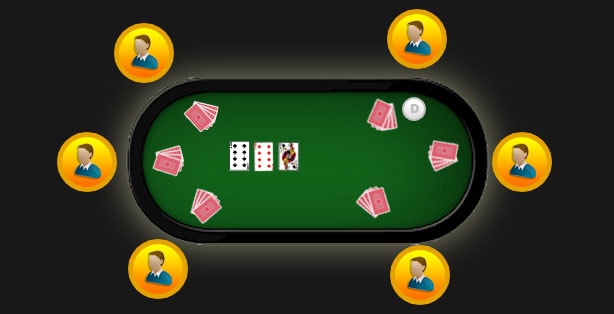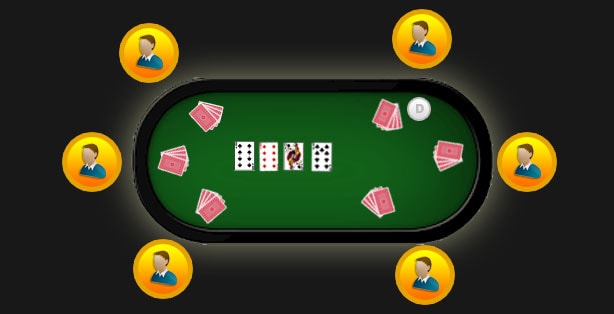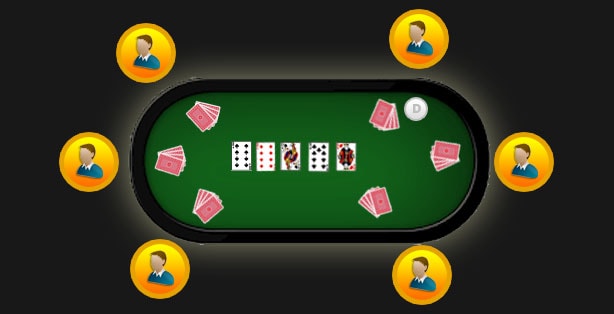Talaan ng mga Nilalaman
Naisip mo na ba kung ang bawat larong poker na binuo pagkatapos ng 7 Card Stud ay kailangang ipangalan sa isang lugar? Sa kasalukuyan ang pinakasikat na laro ng poker sa Lucky Cola online casino ay Texas Hold’em, isa pang sikat na bersyon ay pinangalanan sa isa pang lugar, Omaha. Habang ang laro ay hindi kasing daling hanapin gaya ng walang limitasyong hold’em, ang Omaha ay maaaring maging mas kumikita para sa mahuhusay na manlalaro.
Kasama sa unang seksyon ng page na ito ang buong pangkalahatang-ideya ng mga panuntunan at kung paano maglaro. Kung hindi ka pa nakakalaro ng Omaha o matagal nang hindi nakakalaro ng Omaha, maglaan ng ilang minuto upang basahin ang mga panuntunan bago lumipat sa susunod na seksyon. Lucky Cola Ang natitirang bahagi ng pahinang ito ay puno ng impormasyon upang matulungan kang matutunan kung paano maging isang panalong manlalaro ng poker ng Omaha.
Paano Maglaro ng Omaha Rules
Mga Ranggo ng Kamay
Ang Omaha holdem ay gumagamit ng parehong poker hand structure gaya ng pinakasikat na poker games tulad ng Texas holdem at 7 Card Stud. Ang pinakamataas na kamay ay isang royal flush, na sinusundan ng isang straight flush, four of a kind, atbp. Ipinapakita ng sumusunod na talahanayan ang buong ranggo ng kamay.
| Kamay | Paglalarawan | Halimbawa |
|---|---|---|
| Mataas na Card | Isang kamay na walang ibang kumbinasyon.?Pinahahalagahan ito ng pinakamataas na ranggo na card. | |
| Magpares | Dalawang card na may parehong ranggo | |
| 2 Pares | Dalawang pares ang pinagsama | |
| 3 ng isang Uri | Tatlong card ng parehong ranggo | |
| Diretso | Limang magkakasunod na card | |
| Flush | Limang card ng parehong suit | |
| Buong Bahay | Pinagsama ang isang pares at isang three of a kind | |
| 4 ng isang Uri | Apat na card ng parehong ranggo | |
| Straight Flush | Limang magkakasunod na card ng parehong suit | |
| Royal Flush | Isang straight flush na tumatakbo mula sa 10 hanggang sa Ace |
Posisyon ng dealer
Kapag nagsimula ang laro mula sa simula, ang bawat manlalaro ay makakatanggap ng isang card na nakaharap, na ang mataas na card ay nagsisimula sa laro sa posisyon ng dealer. Sa isang casino o poker room, ang bahay ay nagbibigay ng isang dealer na nakikitungo sa mga card, ngunit para sa layunin ng paglalaro ng laro, ang manlalaro ay palaging itinalaga bilang ang dealer. Kung sasali ka sa isang laro na isinasagawa, ang dealer ay napili at ang laro ay nilalaro.
Depende sa mga patakaran ng casino, maaari kang magsimulang maglaro kaagad, maaaring kailanganin mong tumaya na katumbas ng malaking blind para magsimulang maglaro, o maaaring hindi ka magsimulang maglaro hanggang sa turn ng malaking blind.
Isang puting disc, na tinatawag na button, ay inilalagay sa harap ng player na itinalaga bilang dealer. Pagkatapos ng bawat kamay, ililipat ng dealer button ang isang player sa kaliwa. Ang paglalaro sa posisyon ng dealer ay pinakakapaki-pakinabang dahil maaari kang kumilos nang huli sa bawat round maliban sa una. Ang pindutan ng dealer ay nagsasabi din sa aktwal na dealer kung saan magsisimulang makipag-deal ng mga card. Ang unang card ay ibibigay sa unang aktibong manlalaro sa kaliwa ng pindutan ng deal. Maraming manlalaro ng poker ang tumutukoy sa disc bilang “button” at ang huling laro ay nilalaro bilang “sa button”.
mga blind
Ang manlalaro sa kaliwa ng button ay ang maliit na bulag, at ang susunod na manlalaro sa kaliwa ng maliit na bulag ay ang malaking bulag. Sa Limit Omaha, ang manlalaro na may malaking blind ay dapat maglagay ng mandatoryong taya na katumbas ng nakasaad na kinakailangan ng talahanayan o ang mas mababa sa dalawang limitasyon. Sa isang 20/40 na limitasyon na laro, ang malaking blind ay 20.
Ang maliit na bulag ay isang ipinag-uutos na taya, karaniwang kalahati ng halaga ng malaking bulag. Ang iba’t ibang mga talahanayan ay may iba’t ibang mga patakaran, kaya suriin sa dealer kapag handa ka nang maglaro.
May mga tinukoy na halaga para sa parehong mga blind sa pot limit o walang limitasyon na mga laro. Halimbawa, ang isang Pot Limit Omaha na laro na may $1,000 max na buy-in ay maaaring mayroong $10 blind requirement at $5 small blind requirement. Ang mga blind ay nasa lugar upang gawin ang bawat palayok na nagkakahalaga ng pakikipaglaban. Kung walang mga blind, ang laro ay magkakaroon pa rin ng aksyon, ngunit mas kaunting aksyon kaysa noong may mga blind.
paunang transaksyon
Kapag naitakda na ang pindutan ng dealer at ginawa ang sapilitang pagtaya sa parehong maliit at malalaking bulag na posisyon, ang bawat manlalaro ay magsisimula sa maliit na bulag at maglalakad sa paligid ng mesa sa kaliwa, na tumatanggap ng apat na baraha nang nakaharap.
Ang mga card ay ibinibigay nang paisa-isa sa paligid ng talahanayan hanggang sa ang ikaapat na card ay ibibigay sa button.
pagtaya
Dumating na ngayon ang unang round ng pagtaya, na kilala bilang pre-flop betting round. Ang unang tao sa kaliwa ng malaking bulagGawin ang iyong unang desisyon at magkaroon ng tatlong pagpipilian.
- Tiklupin (itapon ang kanilang mga card)
- Tumawag (taya na katumbas ng malaking bulag)
- taasan (taasan ang laki ng taya)
Sa isang laro ng limitasyon, ang pagtaas ay maaari lamang maging ang laki ng limitasyon sa pagtaya, na nangyayari na kapareho ng laki ng malaking blind. Halimbawa, sa larong 20/40 na binanggit sa itaas, para mapataas sa unang posisyon sa kaliwa ng big bind, kakailanganin mong maglagay ng $40 sa palayok. Ang dahilan kung bakit mo inilagay ang $40 sa palayok ay dahil ang iyong unang $20 ay ang halagang tatawagan at ang pangalawang $20 ay ang halagang itataas.
mahalagang pahiwatig
Dapat mong palaging ipahayag na gusto mong itaas bago ilagay ang iyong mga chips upang maiwasan ang anumang pagkalito. Sa karamihan ng mga poker room at casino, hindi ka pinapayagang isulong ang iyong taya at pagkatapos ay bumalik at makakuha ng mas maraming chips na itataas. Madalas kang makakita ng mga pelikula sa Hollywood at palabas sa TV kung saan sinasabi ng mga manlalaro na tumawag sila at pagkatapos ay tumaas. Ito ay tinatawag na string betting at hindi pinahihintulutan sa karamihan ng mga laro.
Sa pot-limit games, kung gusto mong taasan, maaari kang magtaas kahit saan mula sa halagang kailangan para matawagan ang taya hanggang sa halaga ng pot (kung kasama ang tawag). Maaaring medyo nakakalito sa unang pagkakataon na maglaro ka, ngunit ito ay talagang medyo simple.
Manatili tayo sa 20/40 blind structure, kaya ang maliit na blind ay naglalagay ng $10 at ang malaking blind ay naglalagay ng $20 para sa kabuuang palayok na $30. Oo naman, ang dealer ay nangongolekta ng rake, ngunitKalimutan ang tungkol sa rake hanggang sa maunawaan mo kung paano gumagana ang pagpapataas. Kung gusto mong tumawag, ito ay $20. Kung gusto mong makalikom ng pera, ang pinakamababang halaga na maaari mong iambag ay $40. Ang bayad sa tawag ay $20 at ang pagtaas ng bayad ay $20.
Ang maximum na halaga na maaari mong itaas ay depende sa halaga sa palayok kapag tumawag ka. Ang pagtawag ng $20 ay magiging $50 ang palayok, kaya maaari kang makalikom ng hanggang $50. Upang makalikom ng $50, epektibo kang naglalagay ng $70 sa palayok. Iyan ay $20 para sa iyong tawag at $50 para sa iyong pagtaas.
Pagkatapos kumilos ng bawat manlalaro, ang susunod na manlalaro sa kaliwang tiklop, tatawag o itataas hanggang ang bawat manlalaro sa mesa ay tumiklop o maglagay ng halagang katumbas ng pinakamataas na taya para sa round sa pot. Sa isang hindi nakataas na palayok, ang maliit na bulag ay maaaring magtiklop, tumaya ng all-in na may sapat na upang puwersahang tumaya, o tumaas. Ang malaking bulag ay maaaring tumaas o tumingin.
Kapag nakumpleto na ang unang round ng pagtaya, ang dealer ay nagsusunog ng card at inilalagay ang susunod na tatlong card na nakaharap sa gitna ng talahanayan upang mabuo ang community o community card. Karamihan sa mga manlalaro ng poker ay tumutukoy sa tatlong card na ito bilang flop. Ang mga community card, o community card, ay ipinapakita nang nakaharap sa gitna ng poker table, at ginagamit ng mga manlalaro ang mga ito upang mabuo ang kanilang pinakamahusay na five-card poker hand. Sa Omaha, ang bawat manlalaro ay dapat gumamit ng tatlong community card at dalawang private hole card para bumuo ng kamay.
Sa sandaling matagumpay ang flop, magsisimula ang ikalawang round ng pagtaya, na ang unang manlalaro sa kaliwa ng dealer ay aktibo pa rin sa kamay. Ang manlalaro ay may dalawang pagpipilian.
- suriin (huwag tumaya, ngunit panatilihin sa kamay)
- taya
Ang paglalaro ay nagpapatuloy sa kaliwa, kung saan ang bawat manlalaro ay tumitingin ng isang unbet, tumatawag kung taya, nagtataas kung taya, at natitiklop kung taya. Ang round ng pagtaya ay nagpapatuloy hanggang ang lahat ng naunang taya ay matawag ng lahat ng manlalarong natitira sa pot. Matapos ang lahat ng pagtaya ay tapos na sa flop, ang dealer ay magsusunog ng isa pang card at ang ikaapat na community card (tinatawag na turn card) ay inilalagay nang nakaharap sa tabi ng flop.
Ang ikatlong round ng pagtaya ay nilalaro sa parehong paraan tulad ng ikalawang round ng pagtaya na inilarawan sa itaas. Ang pagkakaiba lang ay sa mga larong limitahan, lahat ng taya at pagtaas sa ikatlo at ikaapat na round ng pagtaya ay ginagawa gamit ang mas mataas na limitasyon. Sa isang 20/40 na laro, ang lahat ng taya sa pagliko at ilog ay $40. Kapag natapos na ang turn betting round, isa pang card ang masusunog at ang panglima at huling community card ay ibibigay nang nakaharap sa tabi ng turn.
Ang huling round ng pagtaya ay kapareho ng ikatlong round ng pagtaya.
showdown
Kapag nagawa na ang lahat ng taya, ipapakita ng natitirang mga manlalaro ang kanilang mga card at ang pot ay ibibigay sa manlalaro na may pinakamahusay na high hand. Kung magtabla ang dalawang manlalaro para sa pinakamataas na limang baraha, hahatiin ang pot sa pagitan ng mga nakatali na manlalaro.
Nabanggit ito ng Lucky Cola sa itaas, ngunit dahil hindi ito katulad ng Texas Hold’em, kailangan naming tiyaking naiintindihan mo. Sa Texas Hold’em, maaaring gumamit ang mga manlalaro ng anumang bilang ng mga card, ngunit kapag naglaro ka ng Omaha, dapat mong gamitin ang dalawa sa apat na hole card at tatlo sa limang community card upang mabuo ang iyong five-card deck.
Omaha pagkakaiba-iba?
Omaha can be played with three different variations or limit structures. Pot limit and limit are two of the most popular, but some poker rooms offer no limit games. Texas hold’em players are usually used to playing no-limit games, and many of them are hesitant to try pot-limit games.
In most cases, pot-limit plays the same as no-limit. If you want to go all-in, the only difference is usually caught early in the hand. Your maximum bet depends on how much is in the pot, so you don’t get as much early hand leverage as you would in no-limit play. Most players adapt quickly to pot-limit games.
Omaha Diskarte?
In order to take advantage of Omaha?mathematical advantages over hold’em, you need to combine additional information with solid strategic decisions. This section includes everything newbies in Omaha need to go from losing to breaking even to winning consistently. Start with the opening hand section, as it forms the basis on which all other strategic decisions work. Once you feel you have fully understood the dos and don’ts of starting hands, you can move on to the basics, intermediate and advanced sections.
starting hand
In every hand in Omaha, the most important decision you will make is whether or not you are willing to enter the pot. Most Omaha poker players start out playing Texas Hold’em, so when they transition to the Omaha tables, they play too many hands. Because they start with twice as many cards as they do at a hold’em table, they think they can play more hands.
Do you know why this is not the right strategy? It doesn’t work because Omaha averages better winning hands than Texas Hold’em. Therefore, you need to have a better final hand to win on average, and the way to get a better hand is to start with a better hand than your opponent. The average winning hand is better because each player starts with four hole cards instead of two. When you consider the best Omaha starting hands, they usually have four cards working together in some way or all independently.
Ang isang kamay ng?mga nagtutulungan dahil ang lahat ng apat na carday maaaring gumana upang bumuo ng isang mataas na tuwid, mayroon kang dalawang magkaibangmga posibilidad ng flush, at anumang flop na may matataas na card ay magbibigay sa iyong maraming mga draw upang mapabuti.
Ihambing ang naunang kamay sa?. Mayroon ka pa ringtatlong matataas na card ngunit wala kang anumang mga posibilidad ng pag-flush at?ang 6s ay halos walang halaga.?Hindi ito magsasama sa anumang bagay
sa iyong kamay.
- important hint
Not all hands with only three strong cards should be folded, but a fourth card that doesn’t help should make you consider how strong the other three cards really are.
Ang mga kamay na may dalawang mataas na pares ay hindi nangangahulugang nagtutulungan ngunit?nag-aalok sila ng dalawang pagkakataon upang matamaan ang isang mataas na hanay at maging isangbuong bahay.?ay isang mahusay na panimulang kamay, at?medyo madaling makawala pagkatapos ng flop kung hindi ka makakatama ng isangset o makakarating ng malaking draw.
Why am I mentioning hands that are easy to get rid of after the flop? Your post-flop performance largely determines your winnings and losses at the Omaha table. Lucky Cola covers more post-flop plays in the Advanced Strategies section below, but the main thing we want you to understand here is that every Each dollar will reduce the profit by one dollar.
You can also put a dollar less in the pot when you have a strong hand. So not only do you lose that dollar now, but you also lose the chance to win another dollar later. This creates a compounding effect where for every dollar you lose now, you lose two or more dollars because you chased a bad draw or lost a hand.
One of the key things to remember when playing Omaha is that every starting hand has to improve to win. Even if you have the best possible starting hand, the odds of winning the pot without improving are very low. In other words, don’t fall in love with a good hand just because you have one. If the flop doesn’t improve your hand or draw you a strong hand, you should usually be looking for the quickest way out. Here are some examples of strong starting hands. They may not work in every situation, but they will work in some.
?
?
?
- Almost any hand with four high cards is a strong starting hand. Four overcards with a flush possibility are even better. 9c is fairly weak, but can be used with Qd and Jc to form a sub, and with Jc to make a flush. You need to be careful with flushes that are not ace high, but you can sometimes win with them. They are much better as backing hands when you have a straight, but they still have a chance to win if the flush hits.
- Two overpairs are great when they hit, but not as often as you’d like. The difference between a high pair and a low pair is that even if you hit three sets, you can still lose if it’s not the top set. The higher your pocket pair, the less likely you are to get a higher set. You can play medium and small pairs, but you have to play them more carefully after the flop when you hit a set.
- A three-card hand with the potential for a nut flush can be quite profitable. Most of your profits will come from having a well-concealed hand when a low straight is likely, not when you hit a flush. Everyone can see the possible flushes, and they know they don’t have an ace, so you probably have an ace. However, if there are 3, 4, 5 or 4, 5, 8 on the table and you have a hand like that, not many players will think you have a straight.
Most of the time, a hand like this won’t turn into a winning hand, so you have to fold when you miss. Even if you flop a pair, you may need to get out of the hand unless you have a strong draw. When you strike, you have to win a big pot with those hands to make up for all the time you don’t win.
If you’re looking for a list of hands you can play, we’re sorry to disappoint you, but every hand and situation is different. Start with the hands Lucky Cola listed above and similar hands, then add others as you can profitably. But don’t do anything until you read the next section. It also has a lot to do with starting hands.
basic strategy
Once you understand the difference between good and bad starting hands, you can learn some basic strategy lessons. Lucky Cola covers the important stuff here, including the following.
Basic Omaha Poker Strategy
Once you understand the difference between good and bad starting hands, you can learn some basic strategy lessons. Lucky Cola covers the important stuff here, including the following.
- How many starting hands you played.
- How to use your position at the table to your advantage.
- How to properly manage your money.
How many hands are played
We’ve touched on this a bit, but you need to play fewer hands in Omaha, not more. Lucky Cola recommends that you only play 15% of your hands throughout the game when learning how to play.
As your ability improves, you can start playing more hands, but we don’t recommend going above 25%. Most strong players start with between 20% and 25% of their hands. You can find some pros who can play more hands, but they are really good after the flop. When you master postflop play, you can play as many hands as you want. But if you’ve gotten to that stage, then you have nothing to learn. Until then, play less instead of more.
how to use positions
Your position relative to the dealer is one of the most important things in any hand, yet most players ignore it. The later you act, the more information you have about your opponent. Even if they’re just checking to see if you know something you wouldn’t know if you had to act on it in the first place.
Some hands are strong enough to be played from any position on the table, but some hands can only be played profitably in late positions. If you don’t consider your own position in every decision you make preflop, you’re not thinking enough.
How to manage your money
It is important to practice proper bankroll management so that you have the opportunity to play in a variety of profitable situations. If a match starts with eight players who play worse than you, it should be quite profitable.
But if you don’t have money to play, no amount of profit will help because you can’t play. When you are learning to play, never play with more than 5% or your total bankroll at any time. This can help you maintain a safe amount of money even during a downtrend. As your game improves, you can play 10% at a time if you want, but we will never play more.
Omaha Poker Intermediate Strategy
Lucky Cola will discuss three points that fall within the middle strategy, as follows.
- pot control
- free rolling game
- table selection
pot control
One of the most important things that winning Omaha poker players do is plan their hands so they can control the size of the pot. This is especially important in pot limit games. As the pot increases in pot-limit games, so does the max raise. When you have or draw the best hand, you want to be able to maximize your potential winnings, so you want to build the pot early if possible.
However, when you draw a better hand but not necessarily a favorite, you may want to keep the pot as small as possible to prevent your opponent from making a larger raise. The maximum bet on the river can be made larger with just one additional bet per round of betting. The chart below shows how much higher the maximum bet can be.
| 2 manlalaro – 1 taya bawat round | 3 manlalaro – 1 taya bawat round | 2 manlalaro – 2 taya bawat round | 3 manlalaro – 2 taya bawat round | |
|---|---|---|---|---|
| Bago mag-flop | $40 | $60 | $80 | $120 |
| Pagkatapos ng flop | $80 | $120 | $160 | $240 |
| Pagkatapos ng pagliko | $120 | $180 | $240 | $360 |
The chart uses a wager of $20 per player. As you can see with the flat bet, one extra bet per round doubles the pot-sized bet amount on the river. One of the keys is determining when you should build up the pot and when you should try to keep it as small as possible. This may seem like a no-brainer, but knowing the best time to build your pot is important if you want to maximize your profits.
- Should you build the pot if you have the nut flush draw?
- Should you build the pot if you have the nut flush draw and open straight draw?
- If you have a set, should you build pots?
The answers to all three questions depend on the situation. It depends on everything else going on in the hand and whether you will win more money in the long run by increasing the pot or keeping it low. Take an arbitrary hand and consider what would happen if you played each way 100 times. In the short run, almost anything can happen, but when you play the exact same situation 100 times, you’ll have a pretty good idea of the expected profitability or value of each occurrence.
example
After the flop you have an open straight draw and predict that you will win every time you hit and you will lose every time you miss. You also don’t call any bets on the river when you miss and predict that your opponent will call a pot-sized bet on the river 50% of the time when you hit Note.
Let’s use the diagram above and assume it’s just you and one opponent in the hand. About 36% of the time you will hit an open straight draw. You’ll hit a straight 36 times out of 100, and 18 of those times you’ll bet $120 or $240 on the river for a bonus. 18 more times you will win the total pot of $120 or$240.
64 times out of 100 you will lose the $120 or $240 pot. You get 18 pot-sized bets on the river, and the total pot size will be $360 or $720. We realize that only half of the money in the pot is yours, but for the purposes of our comparison, you put in 50/50 of the winning hands and 50/50 of the number of losing hands you put in, so these numbers tell us exactly Best way to play.
When you keep the pot small by only calling each round, you win $6,480 over 18 pots, $2,160 over 18 pots and lose $7,680 over 64 pots. Your total win over those 100 hands is $960. If you divide $960 by 100 lots, your average profit per lot is $9.60. This shows that there is a profitable way to play this hand with the parameters we set. But what happens if you make a second bet every round to build the pot?
You won $12,960 over 18 hands and $4,320 over 18 hands,Lost $15,360 over 64 hands. This makes a total prize of $1,920, which is$19.20 per hand. In this case, you’re better off building the pot in the long run. The problem is making all the right guesses when it comes to how often you win when you hit your hand, and how many times and how much you’ll be paid out when you win.
The number of variables and uncertainty make these calculations difficult, but profitable players tend to make the right decisions. You can learn how to do this by experiencing and computing these problems when you’re not playing the game.
Start carrying a small notebook and pen with you so you can write down when such situations arise. Write them down and then do the calculations on them. The next time this situation arises, you will have a good chance of remembering the correct decision based on your calculations. Then start running calculations based on different variables.
In our example, what happens if you only get paid 25% of the time? What if you got paid 75% of the time? What if you won the hand 90% of the time with straights? This can happen if the boards pair up and give your opponent a full house, or if you hit the low end of a straight and your opponent has the high end. See how complicated it is to decide whether you should increase the pot or keep it small? You can rarely predict all variables with 100% accuracy. But with experience, you can learn to get close enough to make the best play.
In the examples we’ve seen above, if you’re getting paid off nearly half the time, then it’s clear that building the pot is the right play. The open straight draw is usually well hidden, so when you hit it, your opponent usually doesn’t realize it. If you go ahead and crunch the numbers at 25% odds, you’ll have a better idea, but in the long run, building the pot seems like the right play in this example.
free rolling game
The next intermediate Omaha strategy you need to learn is the free craps game. Most poker players are familiar with freerolls, tournaments in which you can enter for free and win cash prizes if your score is high enough. This isn’t the type of freeroll we’re talking about here. When two players have the same best hand after the flop or turn, but one has a chance to improve and the other doesn’t, it’s often easy to build a large pot quickly. Many times the pot will be split, but when the player who has the chance to improve hits her hand, she wins a big pot.
example
You and your opponent both flop two hearts on the flop, flopping an ace high straight. You have the Ace of hearts and another heart, so if the third heart lands on the turn or river, you win with a flush, so you want to get as much money in the pot as possible. When you miss the flush, you split the pot, but when you do, you win a huge pot.
You need to be on the lookout for free roll possibilities and position yourself to take advantage of them as often as possible. A big pot can turn a tie or losing round into a winning one. On the other hand, you have to be careful not to get caught in a situation where the dice are thrown at random. If there is a possibility of a flush draw when you flop the nut straight, beware of too much pot building. You might get a free roll.
table selection
The last intermediate strategy you need to learn is table selection. Will you win more money playing poker tables with pros or first-time Omaha players? You’ll always win more in the long run playing against players who play worse than you.
Every time you make the right decision, you win more money, and every time your opponent makes a mistake, it costs them money in the long run. Look for tables and games filled with bad players. Don’t let your ego cost you in a game against better players because your
Ego will cost you money.
Omaha Advanced Strategies
Most players are capable of learning good hand selection, table selection, position and bankroll management, but the best players are able to sustain their strong performances hand after hand. Note that most things so far have involved pre-flop play. Although not easy, the decisions you make before the flop are easier than the decisions you make on the flop, turn, and river.
As each hand progresses, you must constantly try to determine your chances of having the best hand, your chances of improving to the best hand, what your opponents have, and the appropriate amount to bet or call. None of these decisions are easy, but with experience you can often learn to make the right ones. It takes a lot of experience, learning, determination, and willpower to get to the level where you consistently make the right decisions after the flop.
Even if you’re not involved in a hand, you must be willing to focus and be determined to do whatever it takes to be the best player at the table. You have to tackle every conceivable situation until you know what to do every time. It can take thousands of hours, but the payoff can be huge profits at the Omaha tables. This all leads to one of the things that we think differentiates advanced players from amateurs.
Advanced Omaha poker players have a plan for every hand and every part of a hand. They think about how to play every possibility before it happens. Before you even see your starting hand, you already need to know as much as possible about the other players at the table
, and how your position relative to the button position will change the way you play.
Before seeing your hand, you should already know whether you plan to fold, call or raise based on the strength of your hand. You also need to know what you plan to do if a player ahead of you raises. Most novice players don’t think about anything until it happens. Don’t make the mistake of ignoring the advice in this advanced strategy section because it’s not as specific as the advice in the basic and intermediate sections. Start thinking ahead about every hand you play. This can be difficult at first, but as you practice, your mind will quickly expand.
Keep working until you can quickly run through all the possible outcomes in your mind before each phase of the hand happens. You’ll find that you can eventually do this while having a conversation with other players and the dealer, and still keep an eye on your opponent’s gaming tendencies. Once you get to this point and master the basic and intermediate strategies listed above, you don’t need to learn much more.
Omaha Final Conclusion
If you can find the game, Omaha is a great option for Texas hold’em players. Most players make the same mistakes over and over, creating a situation where they can profit from their mistakes. Don’t play too many hands, use the simple math discussed above, and follow all the strategies you’ve just learned, and you’ll be able to reach profitable levels faster than in Texas Hold’em.
Best Online Omaha Casino Sites in Philippines 2023
??Lucky Cola online casino
With over 100,000 registered players and over 10,000 players making successful monthly payments, Lucky Cola Casino is fast and not long. Winning is that simple!
??JILIBET online casino
Ang JILIBET Casino ay mayroong higit sa 100,000 rehistradong manlalaro, ang JILIBET Casino ay ginagawang madali para sa iyo na manalo.
??PNXBET online casino
PNXBET Casino ng pinakasikat na mga laro para mapagpipilian ng mga manlalaro. Ang PNXBET ay mayroong 5,000 mga laro sa casino upang magbigay ng pinakamahusay na karanasan para
??OKBET online casino
OKBET casino allows you to easily cash out/cash in via Gcash. OKBET offers the most popular games in the Philippines, slots, live casino, Sabong Baccarat
??Hawkplay online casino
HawkPlay casino ay isang legal na online casino sa Pilipinas na may libu-libong masaya at kawili-wiling mga laro at slot machine.
??WINFORDBET online casino
Binibigyan ka ng WINFORDBET Casino ng hanggang 50% sa iyong unang deposito! Mag-sign up at makakuha ng 20 pesos agad!
??XGBET online casino
Magbukas ng account sa XGBET para tamasahin ang lahat ng alok sa online entertainment at ang pinakamagandang karanasan sa paglalaro na higit sa iyong imahinasyon. Ang XGBET Casino ay patuloy na nag-aalok ng mga natatanging alok ng deposito at iba’t ibang mga promosyon sa mga tapat na customer.







